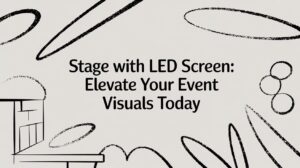
Stage with led screen: Elevate Your Event Visuals Today
Not long ago, a stage with an led screen was just a fancy backdrop. Now, it's the dynamic, beating heart of any modern live event.
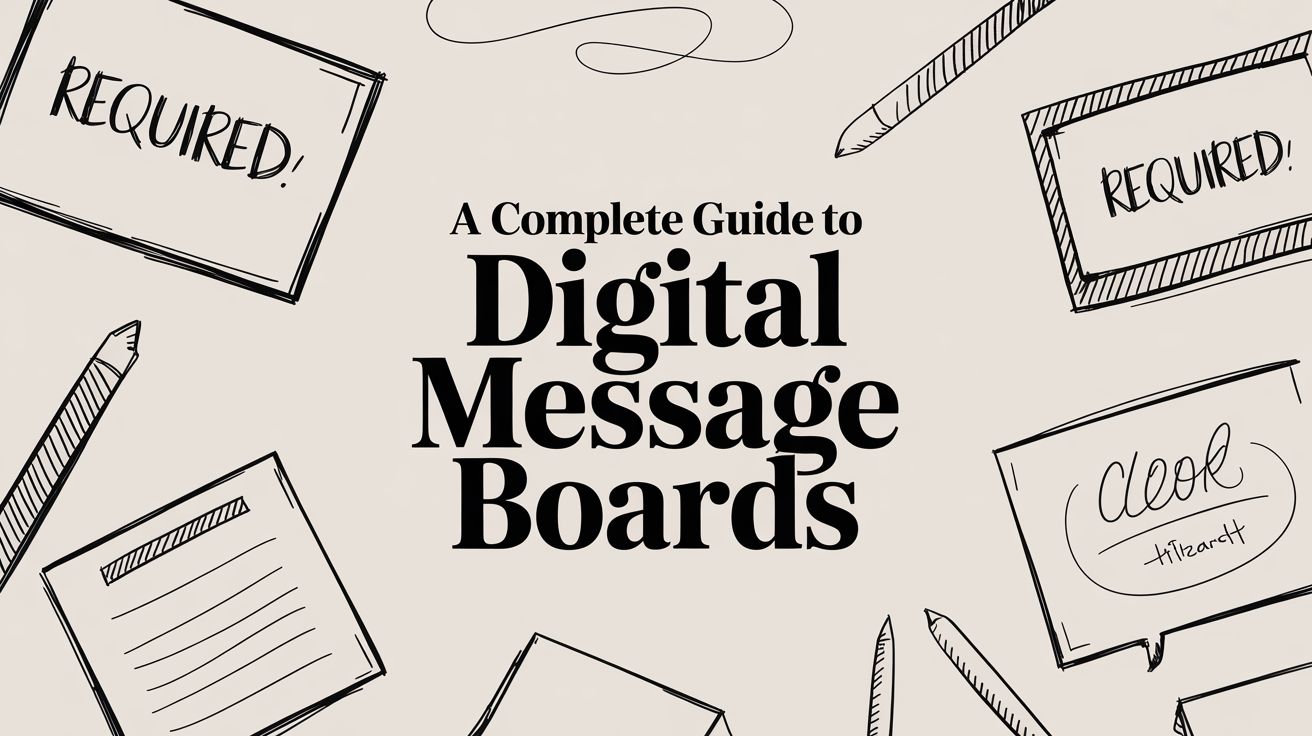
Think about the signs you see every day. Most are static, unchanging—a printed poster or a painted billboard. They do their job, but what if a sign could do more? What if it could change its message in the blink of an eye?
That’s where digital message boards come in. These aren't just screens; they're dynamic electronic displays, typically powered by bright LED or LCD technology, designed to show videos, real-time information, and eye-catching ads. They're a massive leap forward from traditional signs, giving you the power to update your message instantly and grab attention with motion and color.
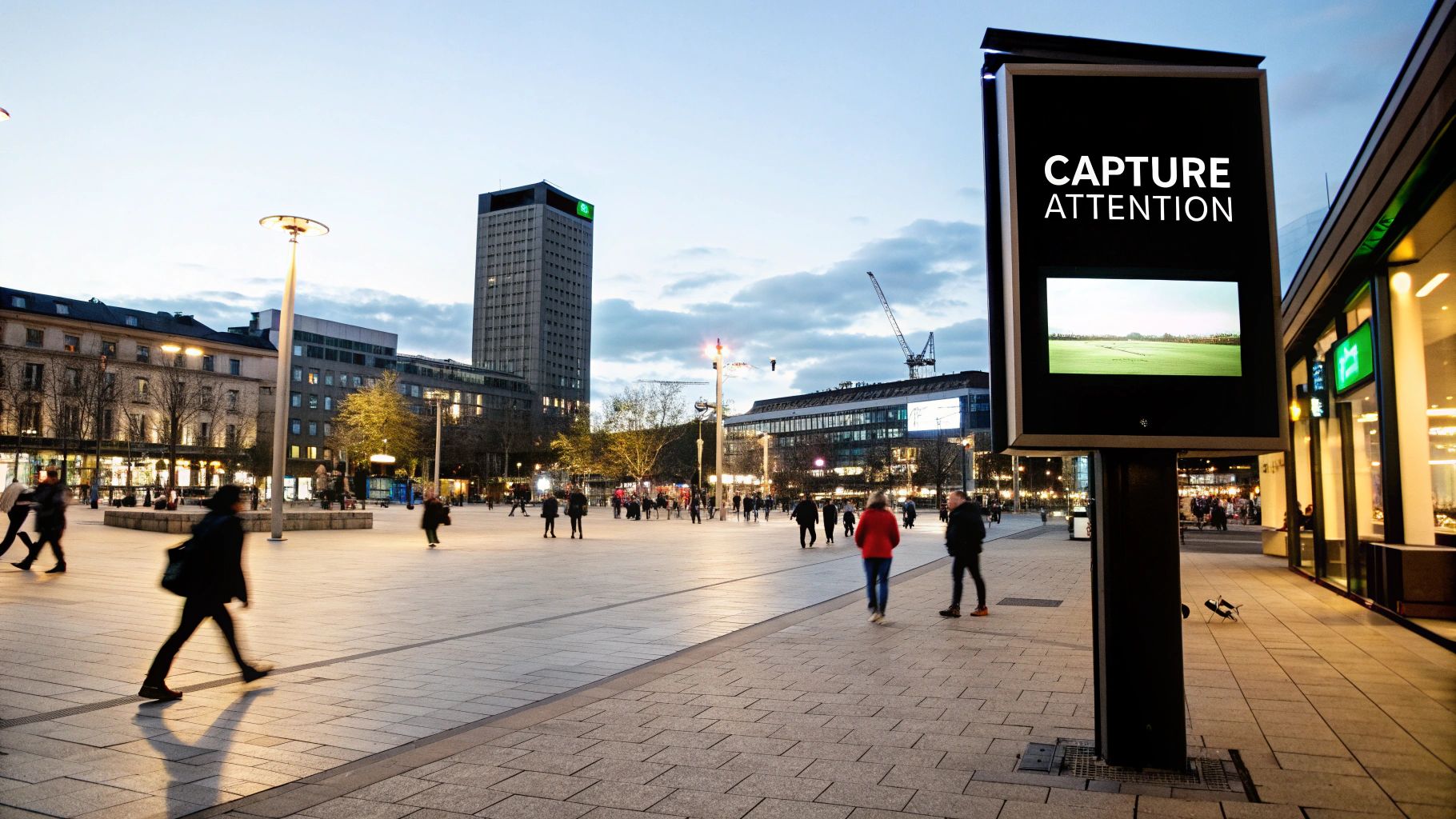
It's like the difference between looking at a single photograph and watching a movie. That’s the kind of jump in communication power we're talking about. These displays are completely changing how businesses, schools, and organizations connect with people, whether it’s in a bustling city square, a corporate lobby, or right outside a storefront.
A printed poster is stuck with one message for weeks, maybe months. But a digital board? It can promote a morning coffee special, announce an afternoon flash sale, and then switch to an evening event promotion—all on the same day, without anyone climbing a ladder. This incredible adaptability makes them an essential tool for modern communication.
To really see the difference, let's put them side-by-side. It quickly becomes clear why so many are making the switch.
| Feature | Static Signs | Digital Message Boards |
|---|---|---|
| Content | Fixed, single message | Dynamic (video, images, text) |
| Updates | Manual, costly, and slow | Instant and remote |
| Engagement | Passive, easily ignored | High, captures attention with motion |
| Flexibility | One message per sign | Unlimited messages and schedules |
| Cost | Lower upfront, high recurring costs | Higher upfront, low operating costs |
| Impact | Limited to one impression | Delivers multiple, timely messages |
The takeaway is simple: static signs say one thing, while digital boards can start a conversation.
Behind every great digital sign, there are three core parts working together seamlessly. Understanding how they connect reveals the magic behind turning a simple screen into a powerful communication hub.
This trio makes it possible to deliver messages that are not just seen, but are also timely and relevant in a way old-school signs never could be. It's no surprise the market is exploding. The global digital signage market is projected to hit USD 45.94 billion by 2030, signaling a massive shift in how organizations communicate.
A digital message board is more than just a screen; it's a dynamic communication platform. It allows a business to become its own broadcaster, sharing messages that are as current as the moment itself and capturing attention in a way that print never could.
At the end of the day, the real value here is the ability to drive action. These displays guide visitors, announce critical updates, and showcase new products with a direct and engaging line of communication. By replacing tired, outdated signs with vibrant, moving content, organizations can finally cut through the noise of a busy world. For a closer look at the different types, it's worth exploring modern Variable LED Message Signs.
Digital message boards aren't just an upgrade; they're a fundamental change in how to communicate effectively. To learn how to find the right fit for your organization, check out our complete guide on LED signs for businesses. They set a new baseline for what’s possible in visual messaging.
To really get what a digital message board can do for you, it helps to peek under the hood. The technology is pretty sophisticated, but the basic ideas are surprisingly easy to grasp. Understanding them is the first step to choosing a display that doesn’t just look good but actually works the way you need it to.
The first big choice you'll run into is between LED and LCD technology. Think of those massive jumbotrons at a stadium, the ones you can see perfectly from the cheap seats even on a sunny day—that's the raw power of LED (Light Emitting Diode). Each pixel is its own tiny, super-bright light bulb, which is why it's the go-to for big, impactful outdoor signs.
Now, picture the sharp, detailed screen on your TV at home. That's a lot closer to LCD (Liquid Crystal Display), which uses a single backlight to light up all its pixels. This makes LCDs fantastic for indoor spots where people are up close and can appreciate those fine details, like in a retail shop or a corporate lobby. But for almost any outdoor message board, LED is the undisputed king.
Once you’re in the LED camp, the next thing you need to know is pixel pitch. It sounds technical, but it’s just the distance—measured in millimeters—from the center of one pixel to the center of the next. A smaller pixel pitch number means the pixels are jammed closer together, which gives you a higher resolution and a much sharper image.
It’s kind of like building a mosaic. If you use big, clunky tiles (a high pixel pitch), you have to stand way back to make out the picture. But if you use tiny, intricate tiles (a low pixel pitch), the image is crystal clear even when you’re standing right in front of it.
This idea directly maps to how far away your audience will be.
Picking the right pixel pitch is all about making sure you’re not paying for a level of detail your audience will never even notice.
So, how do you make a sign that’s easy to read in the middle of a blindingly sunny afternoon? The secret is brightness, and we measure it in a unit called a nit. Just think of a nit as the screen's version of a light bulb's wattage—the higher the number, the brighter the display.
Your indoor TV probably puts out around 250-500 nits, which is more than enough for your living room. An outdoor digital message board, though, is in a constant battle with the sun. It needs way more firepower.
For an outdoor sign to hold its own during the day, you need a minimum brightness of around 5,000 nits. The real workhorses often push 7,000 nits or even higher to guarantee the content stays punchy and readable, no matter the weather.
Last but not least, there are two more specs that are absolutely critical for a sign's performance and lifespan. The first is its IP rating (Ingress Protection). This is just a standardized score that tells you how well the sign’s casing keeps out dust and water. It’s exactly like the waterproof rating on your phone or watch. A common IP65 rating, for example, means the sign is totally sealed against dust and can handle being sprayed with water jets—essential for shrugging off rain and storms.
The second is the refresh rate, measured in Hertz (Hz). This simply tells you how many times per second the screen redraws the image. A low refresh rate is what causes that annoying flicker, especially with video. A high refresh rate (think 1,920 Hz or more) gives you buttery-smooth motion, making your content look professional and easy on the eyes. It's the secret sauce for captivating video that doesn't skip a beat.
Picking the right digital message board isn’t just about where you’re going to put it; it’s about choosing a piece of technology that was born and bred for that specific environment. Think of it this way: an indoor display would be about as useful in a thunderstorm as a paper umbrella, and an outdoor sign brought inside would feel like staring directly into a spotlight.
The jobs they're designed for are just fundamentally different.
This simple decision tree nails the first big choice you'll have to make. Are you trying to grab attention from far away, or are you focused on up-close detail?
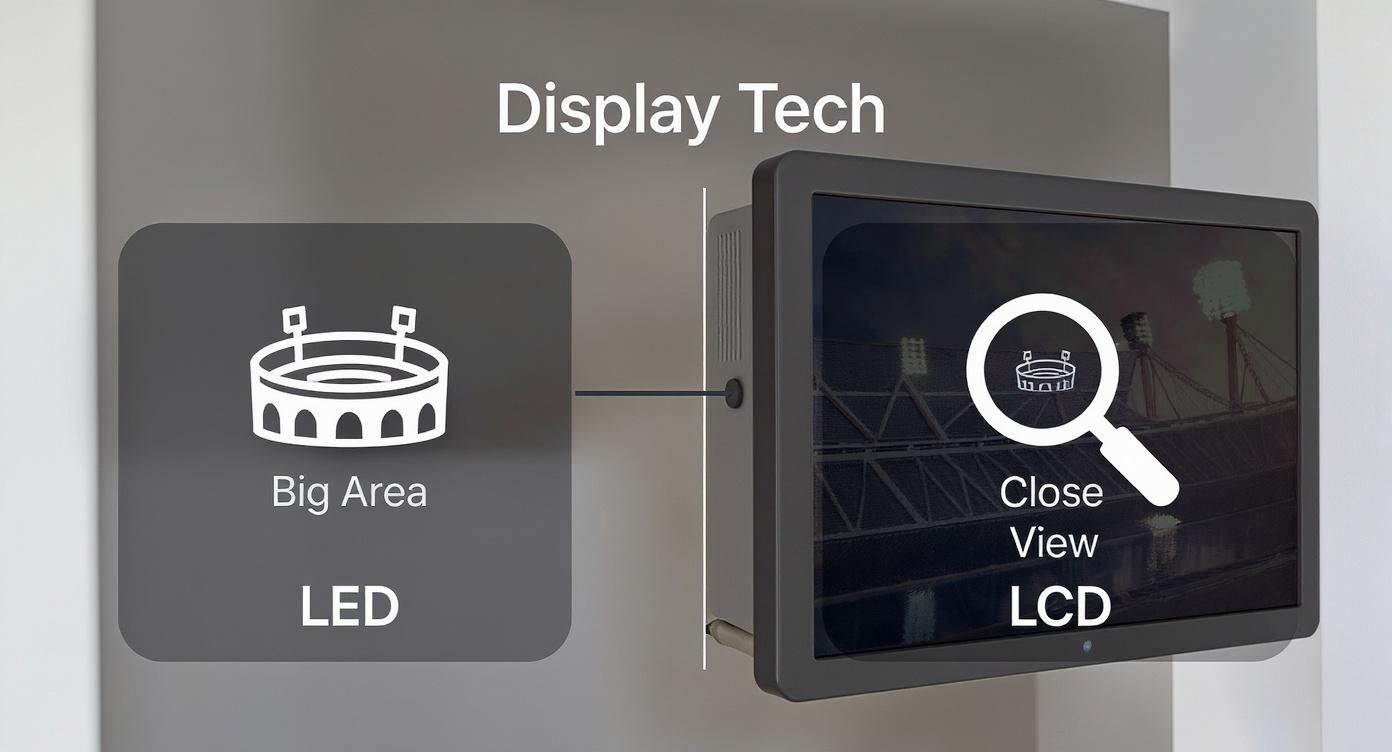
As you can see, for those big, wide-open spaces with distant viewers, LED is the undisputed champion. For close, intimate viewing, LCD is the way to go.
Outdoor digital signs are the rugged, heavy-duty workhorses of the industry. Their number one job is to go head-to-head with the brightest light source imaginable: the sun. This means they need an incredibly high brightness level, often cranking out more than 7,000 nits just so your message stays sharp and readable on a sunny afternoon.
But brightness is only half the battle. These signs are constantly exposed to rain, snow, dust, and wild temperature swings. That’s why a high IP rating, like IP65, isn't just a nice-to-have—it's absolutely essential. This rating is your guarantee that the enclosure is completely sealed off from dust and can handle being blasted with water, keeping all the important electronics safe and dry.
The physical build has to be tough enough to handle high winds and the occasional stray object, too. For anyone seriously looking at this kind of investment, getting to know the ins and outs of digital outdoor signage is the crucial first step toward a successful setup that will last for years to come.
An outdoor sign isn't just a screen; it's a fortress. It must be engineered to perform flawlessly while under constant assault from the elements, 24/7.
Move a digital message board indoors, and the entire game changes. You’re no longer fighting the sun; you’re fighting for the attention of people standing just a few feet away. In this arena, a fine pixel pitch becomes the most important spec. A smaller pixel pitch packs the diodes closer together, creating a much higher resolution for those crisp, flawless images that look incredible up close.
Brightness levels are dialed way back for indoor use, usually sitting between 300 to 1,000 nits. This is plenty for a well-lit room and stops the screen from being painfully bright or making the content look washed out.
Looks matter a lot more inside, too. Indoor displays are designed to complement the interior design, often with slim profiles and bezel-free edges for a sleek, modern feel. Many also bring interactivity to the table, with touchscreen capabilities that let users engage directly in lobbies, museums, and retail stores.
To really drive the point home, let's look at a side-by-side comparison of what these two types of displays are built to do.
| Specification | Indoor Displays | Outdoor Displays |
|---|---|---|
| Brightness | 300 – 1,000 nits | 7,000+ nits |
| Pixel Pitch | Very Fine (0.9mm – 4mm) | Wider (4mm – 20mm+) |
| IP Rating | Not typically rated (e.g., IP20) | High (IP65 or higher) |
| Viewing Distance | Close-up (< 20 feet) | Far (> 20 feet) |
| Durability | Standard construction | Rugged, weather-resistant |
| Interactivity | Often includes touchscreens | Rarely interactive |
| Aesthetics | Slim profiles, bezel-less designs | Functional, robust enclosures |
As you can see, the choice between indoor and outdoor isn't a minor preference—it’s a decision rooted in two completely different sets of engineering challenges and performance goals.
When you're looking at new tech, it always boils down to one simple question: is it worth it? A digital message board is much more than just a bright screen; it's a powerful business tool built to deliver a real, measurable return on investment (ROI). Once you connect its capabilities to your business goals, you'll see it transform from a capital expense into a revenue-generating machine.
Its real power comes from grabbing attention in a way static signs just can’t compete with. Picture a retailer planning a flash sale. With a traditional sign, they’d have to print posters, put them up, and just hope people look. A digital display lets them launch a vibrant, animated promotion in seconds, creating a sense of urgency that pulls people right off the street and into the store.
And this isn't just a gut feeling; the numbers back it up. Digital screens pull in roughly 400% more views than static posters, showing just how massive the advantage of dynamic content is. Even better, digital message boards have recall rates around 83%, a huge jump from the 40% most people remember from traditional print ads.
The ROI of a digital message board really clicks when you see it in action. Different industries find their own unique ways to turn these displays into profit centers.
In every case, the digital board is solving a real problem, whether it's driving sales, making operations smoother, or building a better workplace. That direct problem-solving is what creates such a strong ROI.
A digital message board pays for itself not just by being seen, but by making people act. Whether it’s convincing a customer to walk in, upselling a menu item, or making sure an important message gets through, its value is tied directly to results you can actually measure.
Figuring out the financial return starts with looking at both the initial costs and the potential gains in revenue. While the upfront investment is obviously a big piece of the puzzle, you have to think about the long-term value it brings. For a detailed breakdown of what goes into the initial purchase, check out our guide on outdoor LED sign cost.
Beyond the sticker price, the ROI formula is driven by a few powerful factors:
To get a true measure of how well your investment is working, looking into how Performance Analytics can be crucial for assessing the return on investment of your digital message board campaigns. By tracking which messages are hitting the mark, you can keep tweaking your strategy to get the best possible return. This data-driven approach turns your sign from a simple display into an intelligent marketing powerhouse.

Even the most advanced digital message board is just an empty canvas without great content. While brilliant hardware turns heads, it’s the messaging—the bold visuals, sharp copy, and fluid motion—that truly connects with an audience and gets them to act. Creating effective content is the first step, but managing it efficiently across one or many screens is what unlocks the real power of your investment.
This is where the Content Management System (CMS) comes in. Think of the CMS as the remote control for your entire network of digital displays. It’s the software hub that lets you upload media, build playlists, schedule content for specific times, and check on the health of your signs, all from a single dashboard. Without a solid CMS, even one sign can become a logistical nightmare.
At its core, a CMS gets rid of the need for manual updates, like physically swapping out USB drives on-site. Instead, it gives you total command over your messaging from anywhere with an internet connection. This move to remote management is a game-changer for modern digital signage.
The software side of this industry is booming. The digital signage software market was valued at USD 11.7 billion and is projected to explode to USD 39.8 billion by 2035. This massive growth shows that businesses are realizing hardware is only half the battle; they're now focusing on advanced software to run their digital message boards right. You can dive deeper into this market growth on Research Nester.
When you're picking a CMS, your first big choice is whether to go with an on-premise or a cloud-based system.
For most businesses today, a cloud-based CMS is the clear winner, offering way more convenience and lower operational costs in the long run.
Not all content management systems are built the same. As you look at your options, a few key features are non-negotiable for managing your digital message boards effectively. A good CMS should feel intuitive, not like you need a degree in computer science to use it.
Look for a platform with a clean, user-friendly interface that uses drag-and-drop functionality. This lets anyone on your team—regardless of their tech skills—create and push content live in minutes. The goal is to empower your marketing team, not bog down your IT department.
Another make-or-break feature is powerful content scheduling.
A great CMS lets you do more than just build simple playlists. It should let you schedule specific content to run on certain days, at specific times, or even trigger messages based on outside data like the weather or inventory levels.
This level of automation turns your digital message board from a passive screen into a smart, responsive communication tool.
Finally, make sure the CMS includes these vital management and analytics tools:
By making a CMS with these capabilities a priority, you'll ensure your digital message board network is not only easy to manage but also a source of valuable data that makes your communication efforts stronger.
Getting your hands on a powerful digital message board is a great first step, but the real journey begins after the purchase. To make sure your sign performs brilliantly and safely for years, you have to nail the installation, keep up with maintenance, and understand the local rules.
Think of it this way: skipping these steps is like building a house on a shaky foundation. It might look good for a little while, but sooner or later, you're going to run into serious—and expensive—problems.
Proper installation is non-negotiable. This is way more than just hanging a screen on a wall. It requires a professional to assess the structural integrity of your building or pole, making sure it can handle the sign's weight, especially when the wind starts howling.
On top of that, installers manage the critical power and data hookups. A stable power supply is what prevents annoying flickers or, worse, damage to the internal components. A solid data connection is your lifeline for managing content remotely. Honestly, professional installation is the best insurance policy you can get for safety, longevity, and peak performance.
Once your sign is up and running, a simple maintenance routine will protect your investment. It’s just like a car—you wouldn’t skip oil changes and expect it to run forever. Your display needs a little TLC to keep it looking bright and sharp.
A proactive approach here will save you massive headaches down the road. Just create a simple checklist and stick to it.
Long-term reliability doesn't just happen by accident. It's the direct result of a consistent, proactive maintenance schedule. A few minutes of care each month can add years to the effective life of your digital message board, ensuring it remains a vibrant and effective communication tool.
This is the part everyone forgets. Before you even sign the purchase order, you absolutely must research your local municipality’s regulations for digital signs. Ignoring the rules can lead to hefty fines or even an order to take the sign down completely.
Start by calling your local planning or zoning department. They'll have all the specifics on what you can and can't do. Key things you need to ask about are zoning laws (where signs are allowed), brightness regulations (to avoid blinding drivers), and any permit applications you need to file before a single bolt is turned.
Taking the time to get this right ensures your new sign becomes a welcome part of the community, not a source of frustration.
As you get closer to choosing the right digital sign, you're bound to have a few questions. It’s a big decision, and you want to get it right. Let's tackle some of the most common things people ask us, clearing up the details so you can move forward with confidence.
This is one of the first things everyone wants to know, and for good reason—you’re making a long-term investment. Most quality, commercial-grade LED displays are rated for around 100,000 hours of use.
What does that mean in the real world? It's over 11 years of running 24/7. And that number doesn't mean the sign just dies. It's the point where the diodes are projected to reach about half their original brightness. With a little regular care, you can often push its effective life even further, making it a truly durable asset for your business.
The price tag on a digital message board can swing pretty dramatically, and it all comes down to a few key ingredients: its size, pixel pitch (which determines the resolution), brightness, and whether it’s built to live indoors or brave the great outdoors.
A smaller sign for your lobby might only run a few thousand dollars. But a massive, ultra-sharp outdoor billboard? That could easily get into the tens of thousands.
Don't just think about the initial purchase price. You have to consider the total cost of ownership. That means factoring in professional installation, any software fees, and the creative work needed to keep your content fresh. Looking at the complete picture gives you a much more realistic financial plan.
Absolutely. In fact, playing smooth, full-motion video is a standard feature on virtually all modern digital message boards. The technology is more than ready for it.
The trick is making sure your Content Management System (CMS) is happy with standard video files, like MP4s, and that your video's resolution is a perfect match for your screen's. Great displays have high refresh rates, which is what gives you that crisp, fluid playback without any annoying flicker or choppiness.
You could update some signs the old-school way with a USB drive or a direct laptop connection, but having an internet connection is what truly unlocks their power.
Think of an internet-connected, cloud-based CMS as the sign's brain. It lets you change what's on screen from anywhere in the world, schedule your messages weeks in advance, check on the sign's health, and even push out emergency alerts in a heartbeat. That remote control isn't just a cool feature—it's one of the biggest advantages of having a digital sign today.
Ready to transform your communication strategy? Smart LED Inc. offers factory-direct pricing on a wide range of high-performance indoor and outdoor digital message boards. Get expert guidance and find the perfect solution for your business at https://smartledinc.com.

Not long ago, a stage with an led screen was just a fancy backdrop. Now, it's the dynamic, beating heart of any modern live event.
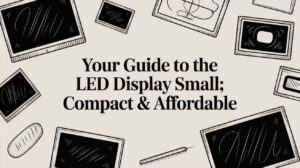
Forget massive stadium jumbotrons for a moment. When we talk about a small LED display, we’re not necessarily talking about its physical dimensions. Instead, we’re
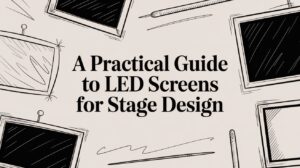
LED screens on stage aren't just backdrops anymore—they're the pulsing, dynamic heart of today's live events. These huge digital canvases are designed to be insanely
"*" indicates required fields